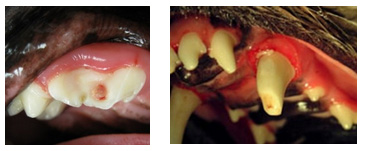 A broken (fractured) tooth is very common to find in dogs. Usually, teeth fracture because dogs are allowed to chew on hard objects like bones.
A broken (fractured) tooth is very common to find in dogs. Usually, teeth fracture because dogs are allowed to chew on hard objects like bones.
Other types of trauma like being hit by a car or a heavy object can cause serious injury to the head as well as the teeth.
When hard chew toys are the culprit, the most common victim is the carnassial tooth. That is the fourth upper premolar and the first lower molar.
The canine teeth will break from head trauma or bad behavior like cage biting.
What happens when a tooth breaks?
First there is pain. It is sharp and sudden then changes to dull and throbbing.
Most dogs will continue to eat and play as if they were completely normal. They may go off food for a day then return to their regular activity. This makes it very hard for most people to know there is a dental problem.
 Next, if the root canal has been exposed, everything a dog puts in its mouth enters the tooth.
Next, if the root canal has been exposed, everything a dog puts in its mouth enters the tooth.
Needless to say, infection quickly sets in and eventually makes its way into the jaw bone. Once the infection is in the jaw, it has a vast superhighway upon which to travel to the rest of the body.
Still most dogs will not complain about a tooth ache until they develop severe symptoms like facial swelling, open draining sores in the skin, and infections in the liver, bladder, or heart.
How is a broken tooth treated?
An infected tooth should be treated rather than ignored.
The goal of treatment is to remove the infection and prevent it from returning.
Surgical extraction may be the only treatment option if symptoms are severe.
This is an invasive procedure that should only be performed by a skilled veterinarian. X-rays must be taken to confirm that the whole tooth has been removed and the jaw has not been broken in the process.
Root canal therapy is another good option for the carnassial and canine teeth.
X-rays must be taken to determine if this treatment is possible for the tooth.
Root canal therapy involves cleaning the infection out of the tooth by using long, thin files and strong disinfectant solutions. Next the clean root canal is filled with material to block the bacteria from returning.
Finally, the crown of the tooth is repaired. Sometimes filling in the cavity is all that is needed.
Other times, a metal crown is required to protect the tooth from further damage.










